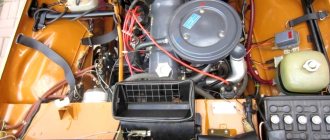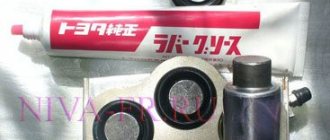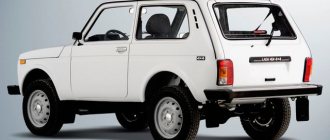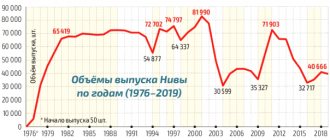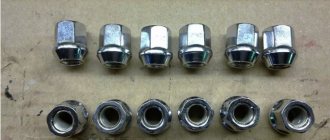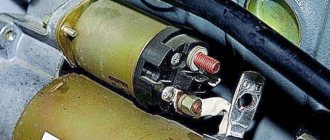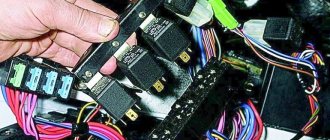Replacement and repair of Niva Chevrolet gearbox
Replacement and repair are the same thing. In both cases, the gearbox is removed. Only in one is disassembly and troubleshooting, in the other is the process reverse to removal - installation of a new gearbox. Removing the gearbox is performed in the following sequence:
- The gearshift knob is removed from the interior side. To do this, you need to press the lock with a screwdriver. However, you don’t have to remove it at the root, but simply unscrew the handle.
- In order to lighten the weight of the box and prevent oil from leaking, it needs to be drained. There is nothing complicated, the process is similar to draining oil from the engine.
- After this, remove the driveshaft that goes to the transfer case. A mark is required before removal.
- Remove the flush shaft and the mechanism responsible for selecting the desired speed.
- When removing the box, the exhaust pipe will get in the way. Another name for it is “pants”.
- After this, everything attached to the gearbox is removed - the speed sensor and the clutch cylinder. Thus, it is necessary to release everything that is attached to the box and the engine at the same time. All that remains is to unscrew the fasteners and with a partner pull out the gearbox. However, this can be done alone - using a special stand.
There is nothing complicated about repairs either. The box is completely disassembled and defective. It is necessary to inspect the gears for wear. For quality repairs, worn components need to be replaced. Be sure to replace all oil seals and seals. It wouldn't hurt to change the clutch right away. It is recommended to replace the bearings without fail.
It is worth noting that the weak point is 5th gear. She stands higher than the rest and receives less lubrication. Determine the condition of the latch. If it is worn out, the 5th will fly out at speed, which is not very pleasant or comfortable. In addition, it can fly out due to wear of the gear teeth. The unscrewed shank nut also makes its contribution. Do not forget about backlash in the mechanisms - they are unacceptable, otherwise they will manifest themselves in knocking when starting off.
The gearbox is installed in the reverse order of removal.
replacing the Niva clutch slave cylinder
The clutch master and slave cylinders can also cause big problems. I had a leaky clutch giving the effect of the clutch sticking. Sometimes it was impossible to turn off the transmission, sometimes to turn it on. We remove the front cardan, we have already removed it. The flange of the front gearbox is visible, i.e. if the cardan was in place, it would be impossible to unscrew the rcs. Bolts 13, two pieces. It is advisable to photograph the mount itself as it stood. And then (six hours later) I twist it in my hands and can’t remember how it stood.
The cylinder is covered in snot, it’s obvious that it’s dead. Code to buy new 2101-1602515
That's it, the cylinder is removed, the new one is installed in the reverse order. But first I also changed the main one, it goes higher up the hose.
Pull the clutch cable
On Niva I try to buy everything from the factory, from Lada-Image in blue and white boxes. New slave and master cylinders.
FakeHeader
Comments 99
Good day, a question has arisen, namely about simplifying this design. just take two flanges without welding and put a spacer between the cardan and the box, thereby allowing it to be adjusted to the distance between the box and the RC
Hello. Do not quite understand. Without welding, two forks and a spacer, on bolts. Why not? If only it didn't hurt
Can you find out the size of this welded washer? Or is this an individual size?
Depends on the crosspieces used
And from the Volga it matches the holes?
Can not say.
thank you, I’ll check it myself and write back, the Volga crosspieces will be stronger
And I installed this while the RK is in neutral, there is no vibration, but as soon as I accelerate the RK dances, but under load it bows out a little and there is vibration... if you install a third support... can you advise?
The third support is needed in principle. I have never seen any jumping, swinging transfer cases other than the Niva. With any shaft, if there is an uneven load on the axles, they try to break free))
And I installed this while the RK is in neutral, there is no vibration, but as soon as I accelerate the RK dances, but under load it bows out a little and there is vibration... if you install a third support... can you advise?
It is also necessary to check the cardan shafts so that the crosspieces work without jamming, otherwise the biting joint will try to turn the transfer case, which will also result in shaking and vibration. Well, and a third support so that she sits without rocking the boat.
Hello. Interesting idea. I'm just busy looking for a suitable solution for replacing the seal. There are only some doubts. 1. The so-called “rudimentary” element in the form of a rubber coupling is present even on some modern foreign cars (for example, bmv x5, as far as I know). 2. This type of shaft (with a constant length) serves as the third support of the river. But only in the case of the usual third support does it hold on to the body, and in this case this improvised support “holds” on the bearings rk and kp. Those. all loads to hold the gearbox and gearbox on one axis fall on the bearings of these units, their seats, as well as on the front cover of the gearbox and its flimsy attachment points. And I’m afraid that the photographs presented confirm this (RK is all “snotty”). Please tell me, is this so?
Self-repair of transfer case on Niva
There is nothing fundamentally complicated in the design of the multiplier, except that it itself is not attached to the main gearbox as on more modern all-terrain vehicles. Intermediate driveshafts extend from the transfer case to the manual transmission. The rest of the device is represented by gears, satellites and bearings. The design also includes a free differential with locking.
Tools
- Spanner 13.
- Flathead screwdriver.
- Key for 10.
How to remove a box from a car
- The machine must be installed on an inspection hole or lift.
- The transfer case levers are set to the neutral position.
- The lining of the central floor tunnel is removed.
- The tunnel cover must be removed to gain access to the transfer lever hatch
- The handles and lever covers are removed.
- The handles and covers of all levers can be carefully removed
- The lever hatch cover is removed using four screws.
- We get access to the insides of the transfer case
- The speedometer drive is disconnected from the transfer case.
- You need to remove the sensor connected to the speedometer from the transfer case.
- The driveshafts are removed from the front and rear.
- Cardan shafts fit to the transfer case front and rear
- After unscrewing several fasteners, the transfer case housing is removed. It’s enough to just push it forward a little (if you look in the direction of the car’s movement, backward) and down. We push with one hand and hold with the other.
- When removing the box, the main thing is not to overdo it
Installation, centering and adjustment
- Install the engine mount brackets correctly.
- Install the transfer case without fully tightening the bolts of its fastenings.
- The flanges of the drive shaft of the box must coincide with the intermediate driveshaft.
- Install the transfer case supports and secure the fasteners.
- Connect the transfer case to the front and rear universal joints, and reinstall the differential lock sensor.
In what case is replacement performed?
The gearbox is simpler than the engine, but sometimes it needs replacement. Often wear and damage force the car owner to buy expensive spare parts. Ultimately, the sum equals a used box in good condition. In this case it is better to change. Thus, a used box will be the best option.
In addition, replacement may be required after severe impacts and destruction of both the gearbox housing and internal mechanisms, which “dragged” along the parts of the fastenings to the housing. The price of a new Niva box is not high. Thus, repairs will cost the car owner less than many analogues.
Repair of intermediate shaft Niva VAZ 21213, 21214, 2131 lada 4×4
| We disassemble the intermediate shaft to replace the elastic (rubber) coupling or constant velocity joint. We mark the location of the coupling relative to the flange,... ...as well as the number and location of balancing washers relative to the coupling. |
| While holding the bolts from turning with a 19mm wrench, use a head of the same size to unscrew the three nuts. |
| Disconnect the coupling and flange. |
| By turning the hinge, remove the bolts from the holes in the elastic coupling flange. |
| Using a screwdriver, remove the plastic plug. |
| Squeeze the clamp with sliding pliers and remove it. |
| We use a screwdriver to move the plastic casing... |
| ...and remove the rubber protective cover from the constant velocity joint housing. |
| We place the hinge body on the open jaws of the vice and, striking through a soft metal drift at the end of the elastic coupling flange, knock out the flange. |
| Separate the hinge and flange. |
| Pull the plastic casing off the rubber boot. |
Pulling off the rubber boot...
| ...we compress the clamp with sliding pliers and remove it. |
| Remove the rubber protective cover. |
| Using a screwdriver, remove the hinge retaining ring. |
Disassembling and assessing the condition of the hinge parts are similar to the corresponding operations described in the chapter Front wheel drive.
We assemble the intermediate shaft in the reverse order. We put 20 cm3 of CV joint grease into the rebuilt or new hinge. Before connecting the hinge to the flange of the elastic coupling, install a small clamp of the rubber protective cover.
| We press the hinge onto the flange, striking through a piece of pipe onto the hinge holder. |
| Before installing the rubber coupling, we compress it with a clamp. |
We place the used coupling according to the marks relative to the flange. We place the previous balancing washers according to the marks relative to the coupling. When installing a new coupling, the shaft assembly may need to be balanced.
Chevrolet Niva Manual
Chevrolet Niva Removing the intermediate shaft
We carry out the work on an inspection ditch or overpass.
Using a 13mm wrench, unscrew the four nuts securing the intermediate shaft joint housing to the flange of the transfer case drive shaft. We put a worm-type clamp on the elastic coupling. The diameter of the clamp must be at least 150 mm. You can use two clamps with a diameter of about 80 mm connected to each other.
Using a 19mm spanner, unscrew the nut of the bolt securing the clutch to the flange of the secondary shaft of the gearbox, holding the head of the bolt from turning with a wrench of the same size.
We take out the bolt. While turning the intermediate shaft, similarly unscrew the nuts of the other two coupling mounting bolts and remove the bolts. By moving the intermediate shaft in the direction of the gearbox, we remove the pins of the hinge housing from the holes in the transfer case shaft flange...
Flush hole between the gearbox and transfer case in NIVA-VAZ-2121-21213-21214-2131
At the beginning, when I just bought the Niva and looked at the design of the shaft between the gearbox and the transfer case, I was very surprised by the design. Especially to the point that the transfer case needs to be aligned relative to the gearbox using adjusting plates and... in general, this is unrealistic! Still not understanding why the designers made such a mistake
promval 21213
and not like the same GAZ-69 and etc. of the crosspiece-crosspiece type and a movable spline connection
GAZ-69 flume
And so the idea of a CV joint-CV joint was born.
But everything would have remained in my head, because in Saratov I didn’t find a person who could cut the splines, so I made a couple of rollers for testing, I installed one for myself, and I bought the second from him.
And this roller lay idle with me from May to August. I decided to combine the replacement of the transfer case with the installation of an exhaust valve.
I gave it to a turner at work to drill the axle/transfer case flange under the gearbox seal. And making the washer. There was no good steel, there was only a nail, so they made a puck for me from a checkpoint helicopter. The thickness of the washer is 5 mm.
First, I assembled one end of the roller. I pressed the CV joint on the side of the retaining ring, added grease, hammered in the plastic plug and put on the boot. And I calculated which side the moving part would be on. My moving part is on the gearbox side, where the distance from the CV joint to the nut is greater.
"BEFORE"
I removed the transfer case and removed the helicopter from the gearbox. At the gearbox, I measured how much the nut can be screwed on, cut off the nut, since its end does not play any role, and the stroke of the shaft is limited
I installed a ground flange with a washer and tightened the nut onto the threaded fastener. Using a grinder, I cut off the end of the gearbox shaft flush with the nut. That's it, now there is no return, you won't be able to install the flush!
THERE IS NO ROAD BACK!
Then I put the RK in the same place along the footprint of the pillows and measured the distance between the flanges. I cut off the excess end of the roller and installed the roller without the second CV joint to make sure that the distance was enough. So I removed and installed the roller 3 times. I trimmed it a little and put it back on. When the distance became ideal, I put on the boot and the second CV joint and applied lubricant. The plastic CV joint plug is not needed here.
He unscrewed the transfer case, hung it on a stand and moved it back so that the roller could fit through freely. The connection of the gearbox flange with the CV joint was sealed with sealant. I lifted the transfer case and screwed its supports to the body.
AFTER
Promval CV joint-CV joint
I did not replace the studs on one side of the CV joint with bolts to make installation easier; I decided that it would be more reliable with studs and self-locking nuts. I screwed the cardan shafts... you can go!
The promval was tested for 1,300 km, sometimes carrying sawn wood under harsh loaded conditions. Everything is great, but there are a number of disadvantages
:. — First, previously the strong rocking of the RK held the sway, but now the sway has given complete freedom to the RK and she hangs freely on two pillows. You definitely need to install a third support! — Secondly, immediately after installation, there was strong vibration during dynamic acceleration or heavy load. Gradually the vibration went away. The new CV joints were to blame for everything; they worked very hard to turn.
Pros:
— There is no need to set the RK. — You can tilt the steering wheel back, thereby unloading the crosspiece of the rear cardan, that’s actually what I did. — At speed 90 there is no more vibration, and at any other speed there is no more vibration. — The car also has a better “feel”; it feels like there is a tight connection in the transmission with the engine. For three days I couldn’t get used to it, I stalled at traffic lights and it was hard to start uphill at first.
In time I went to change all this. But what happened to the native industrial site
Native industrial site
A little more and the coupling would have completely torn apart, and then I would have simply stood in the middle of the road.
https://www.drive2.ru/l/288230376152433027/
next article:
Installing a Valeo clutch from Niva Chevrolet to Niva
With every new thousand km, it was felt that the clutch was asking for replacement. And then one fine day the car just stops
remont-vaza.ru
Flush shaft, elastic coupling, vibration (part 2)
So, the clutch was changed. But the joy was short-lived. I drove about 10 thousand km until October 2022. And again, like last time, I was driving to the dacha (only this time I was on the border of the Moscow region), suddenly I felt a slight twitching, literally for a second. Well, I think this is another “asphalt defect”. Then again, again and more often. In Ryazan, a scoundrel traffic cop stopped me because there was nothing to do... And then I set off with that familiar shaking of the transfer case back and forth. This time the “oscillations” were periodic and less predictable (appeared mainly when driving over potholes, when the axles pump the cardan shafts and the transfer case with them), I immediately realized that now it was the CV joint that was sticking. There are no options here - forward and only forward! I've arrived! I firmly decided not to contact that service, but to pull back to Moscow and go to the specialized Nivsky. Again I went through the procedure with loosening the support nuts and making a small passage so that the transfer case would fit where it would like it most. When cold the car drove more or less normally, but the longer it went the worse it got. Even with a torn coupling, I wasn’t as worried as I am now: I bought the coupling on the way, and these wedges can lead to the CV splines turning or breaking (there are many cases when, even for no apparent reason, the shafts rotate and break in half). I drove to Moscow stopping more often so that the CV joint could “rest” a little. I've arrived! And for the second time I was convinced: Niva will be lame, but it will get there! I started looking for reviews on services, and what other design options for industrial shafts there are. I wanted to put it on a crosspiece, but I couldn’t even imagine where the old “Soviet” one could be found in good condition, and there are no good reviews for the new ones (such as from the “NIVA-LADA 4x4”), but there are reviews that their crosspieces are not symmetrical, which brings wild vibrations. And since the car spends most of its time in the city and on the highway, I didn’t want to sacrifice comfort.
Also on sale was a Sonda flush with two reinforced (unlike ours) couplings from BMW. But there is also no positive information about it, only a post here on Drive that this is an unsuccessful design.
I also once saw a Sonda flush on two CV joints. In my opinion, although I am not an engineer by training, this is the most correct design, allowing the gearbox and manual transmission to be in any position relative to each other. This design received positive reviews, but Sonda discontinued production due to jamming incidents. I have read a lot about Nivsky services, everything has both positive and negative reviews. Based on the predominance of positive ones, I chose Niva 777. I left a request for repairs on the website: I outlined the situation, wrote that I was ready to install a spacer on the crosspiece, a subframe - anything, as long as this unit did not fail so quickly. They called back almost immediately, they don’t have grooves on the crosspiece, and if you bring your own, they won’t give a full guarantee on the work. The original CV joint is available. Well, so be it. In general, it took me an hour and a half to replace the seal (it costs a little more than in stores, but there is a full guarantee on the work; all together it cost about 7,500 rubles). The transfer case on the lift was centered. Feelings when leaving: the transfer case levers are almost motionless, but there is a noticeable vibration at the gearbox. I picked up the second broken failure (now I have a small collection of scrap metal at my dacha), the master said, “The CV joint is sticking on something.” I looked at this something: the plastic cap was hanging loose at the end, but there was no grease inside, just rust... And then I remembered: in the summer when I was crawling under the car I saw that the entire tunnel inside was splashed with greasy black grease (obviously not oil from the transfer case). The CV joint boot was intact, it’s not clear where the pressure came from. Well, I thought: since the lubricant is pressing, it means it’s there, it’s just extra... Then I rinsed the bottom with a mini-wash, waded... Then autumn with the rains... In general, the cause-and-effect relationship is clear. It looks like it wouldn’t hurt to additionally glue the cap onto the sealant for the new flush shaft
... The wash shaft was installed with a new coupling from 2123, but again there were no balancing washers and grooves, and one bolt was longer than the others (at that time, ready-made wash shafts with a Shniv coupling, it seems, were not available, they were later installed on the conveyor and produced as a spare part) which probably means that they changed the coupling themselves.
And from this it already follows that the structure is not balanced... To summarize: I drove a total of about 900 km on a torn clutch and a wedging CV joint.
Did this pass without a trace for the gearbox and transfer case? At that time I did not notice any particular increase in noise from them. Perhaps the first washer purchased was not original, perhaps it was a craftsman’s mistake (I dropped it and the cover fell out, the key fell off and damaged the coupling, the centering sleeve flew out and took out a piece of donut...). I still ride on the second washout to this day. The clutch is not cracked, the CV joint does not throw out grease, does not rattle or jam. I don’t know how long it lasts, I’m studying replacement options, I carry a spare clutch and large clamps with me (theoretically, to replace the clutch, it’s enough to tighten the installed clutch with a clamp, remove the bolts and move the transfer case without removing the cardan shafts...) Vibrations occur periodically... More on this in the next series ...
Source
Promval Niva Chevrolet, theory
As a rule, when transmission vibrations occur in fields and shnivy, everyone rushes to look at the cardan shafts. There is, of course, some truth in this, except for one remark. In the theory of machines and mechanisms, there is a recommendation: start looking for the cause of vibration either directly from the source of rotation (that is, the engine itself) or from bodies of rotation that have a high angular velocity. Let's go down the chain. The first is the flywheel with clutch. Nothing can happen to it after capitalization or installation, except that when replacing the crankshaft cuff, it could be put in a different position. Next comes the clutch disc, clutch basket, gearbox, centering rubber-metal bushing and finally the Chevrolet Niva flush. The clutch kit consists of metal rotating parts, and, if the manufacturer is of a good level, as a rule it does not produce vibrations. But the hero of this article contains ball joints, a rubber coupling and a spline connection. When the slightest play occurs, vibrations have room to roam. In the vast majority of cases, the rubber coupling is to blame. Yes, it is sold separately, BUT the assembly requires balancing after assembly. There's a dead end here. Even in my native St. Petersburg, there are no companies where this can be done in good quality. The best option is to take a new assembly.
Replacement
Before carrying out work, it is necessary to provide access to the lower part of the car by installing it on an overpass or inspection hole.
To change drives you will need:
- Balloon wrench.
- Jack.
- Keys for 13, 17 and 27.
Replacing the drive is done as follows:
- Unscrew the cardan from the front gearbox.
- Jack up the car.
- Remove the front wheels.
- Unscrew the shock absorbers from the lower control arms.
- Unscrew the nuts holding the CV joint bearing housings.
- Unscrew the gearbox from the front suspension cross member. To do this, you will need to unscrew the bolts and nuts holding the housing and fastening the suspension brackets of the unit.
- Raise the gearbox and secure it in the raised position.
- Remove the protective cap from the front wheel hub and unscrew the nut.
- Remove the centering sleeve.
- Raise the front lower control arm by compressing the suspension spring.
- Unscrew the ball joint.
- Move the steering knuckle to the side.
- Unscrew the fastening and move the exhaust pipe away from the exhaust manifold (this operation is necessary when replacing the right-hand drive).
- Pull the gearbox back.
- Remove the drive.
Installation is performed in the reverse order of removal.
When and how do you need to change the seals of the VAZ 2123 transfer case?
Reference! Parts must be replaced if transmission oil leaks occur at the interface between the drive shafts and the transmission housing.
If this is not done, the transmission will leak. Without lubrication, transfer case parts will quickly fail.
Step-by-step instructions for replacing the oil seal of the Niva Chevrolet
To work, you need to have free access to the bottom of the car. Therefore, replacement of RK oil seals will be carried out on an inspection ditch, overpass or lift.
You will need the following tool:
- hexagon 12;
- open-end or socket wrench 24;
- waste container;
- flat screwdriver;
- hammer;
- mandrel;
- syringe for filling transmission oil;
- new self-locking nuts for fastening the flanges.
The algorithm for replacing the Niva Chevrolet transfer case oil seal is as follows:
- drain the oil from the transfer case into the prepared container;
- unscrew the bolts securing the cardan, the drive shaft oil seal of which is to be replaced;
- engage the gear, lock the differential and put the car on the handbrake;
- Unscrew the nut securing the propeller shaft drive flange.
- remove the washer;
- pull the flange off the shaft;
- use a screwdriver to remove the old oil seal;
- clean the seat and apply sealant;
- lubricate the rubber seal of the new oil seal with oil;
- using a mandrel and a hammer, press the part into place;
- install the flange and washer, tighten them with a self-locking nut;
- secure the cardan.
Important! The self-locking design does not allow for reuse of parts. Therefore, the flange nuts must be replaced with new ones.
After completing the work, it is necessary to fill the transfer case with fresh transmission oil.
Removing and installing the rear propeller shaft
Before removing the Chevrolet Niva rear driveshaft, you must set the gearbox lever to the neutral position and release the handbrake. In order to maintain the balancing of the driveshaft after installing it back on the car, when removing it, you need to mark, with paint or a center punch, the position of the shaft housing and the holder of the differential drive gear shaft crosspiece.
The intermediate stage has been completed. Now, to remove the universal joint, unscrew the bolts and remove the rear universal joint clamps. To prevent the propeller shaft from turning when the flange bolts are loosened, you need to thread a screwdriver through the crosspiece holder. We attach the needle bearing caps to the spider body with tape or tape to prevent them from falling when the driveshaft is removed.
We lower the driveshaft, namely its rear part. After this, we remove the cardan, or rather, its front part, from the transfer case. Having removed the cardan, the transfer case is wrapped in a regular plastic bag. This is necessary to prevent loss of transmission fluid, as well as to prevent contamination of the internal elements of the removed driveshaft.
When installing the cardan back into place, you need to use the clamps of the crosspiece holders. It is necessary to remove the plastic bag from the transfer case and thoroughly wipe the free surface. Then the driveshaft is inserted into the transfer case. Next, take the cardan by the back and set it to its original position. In this case, it is necessary to ensure that the installation marks match. If they do not match, then rotate the rear wheels and ensure that the marks on the drive gear flange align with the marks on the cardan. Remove the tape or insulating tape that secured the bearing caps and install new clamps and bolts. This is how the driveshaft is removed and installed.
What is a crankshaft oil seal and how does it work?
During operation, all engine parts are fairly well washed with engine oil. Oil lubricates moving parts and reduces friction, extending the life of the mechanism. But what about the parts that come out? A striking example is the crankshaft, part of which is connected to the flywheel. After all, when such a part is brought out, oil can flow through the hole for the rotating shaft.
To prevent this from happening, to seal the hole under the shaft, the designers provided a part made of sealed material - the crankshaft oil seal. It is made of silicone or fluorine rubber and is an o-ring with a diameter equal to the diameter of the crankshaft (in the case of the rear oil seal, approximately 99 millimeters). These materials are heat-resistant, which allows the oil seal to be protected from the harmful thermal effects that occur during friction.
Special inscriptions are made on the outside of the seal. Basically, they talk about the direction of rotation of the crankshaft. This information allows you to correctly install the oil seal when replacing it.
What does it look like
These sealing elements are made of silicone or fluorine rubber. These materials were not chosen by chance - they are resistant to high temperatures, as well as to the effects of lubricating fluids. This allows you to completely avoid the risk of damage to the part due to overheating that occurs during friction. In fact, the part is a ring. The size is equal to the diameter of the engine crankshaft.
Working principle of the crankshaft oil seal
The oil seal is installed in the place of the block where the crankshaft comes out. In classic cars, where the engine is installed along the hood space, and gas distribution occurs via a metal chain drive, the oil seal is installed in the crankshaft shield in front of the support bearing. Front-wheel drive engines or those with a rubber timing belt are installed in the block itself, since shields are not used on them. However, in both cases, the oil seal has the same purpose - to prevent oil leakage from the cylinder block.
Oil pressure is created inside the crankcase, which presses the oil seal against the parts being sealed. Thus, it ensures reliable sealing of the engine against lubricant leakage.
Where installed
The seal is installed on the engine block in the place where the crankshaft exits the block to the outside. This location may differ on different cars and internal combustion engine models. So, on classic rear-wheel drive VAZs, where the engine is located longitudinally and the timing chain drive is chain driven, the oil seal is installed in the crankshaft shield behind the support bearing. On front-wheel drive cars, the engine is located transversely, and the timing mechanism is often belt-based. The oil seal in such engines is installed in the cylinder block due to the fact that there are no crankshaft shields on such internal combustion engines.
Types of crankshaft oil seals
Manufacturers, in order to save materials or reduce prices, produce crankshaft oil seals with sections of varying complexity. Let's consider their main types, namely:
- with a metal outer surface (option a);
- with a smooth surface (option b);
- with a corrugated surface (c);
- with hydrodynamic effect (d).
Types of oil seals
Model a seals will not provide the same degree of sealing as models b-d, but require less rubber for production and lower cost accordingly. A smooth oil seal (type b), even with sufficient density, will have cavities in the seat; such an assembly may “sweat”. Grooved grooves (like those of oil seal B) are crushed during installation and contribute to a tighter fit in the engine housing, this is an advantage over “bare” oil seals (a).
Special mention should be made of hydrodynamic seals (model d). They are more technologically advanced and efficient. The principle of their operation is as follows:
- special notches of small depth with the direction of rotation are applied to the inner plane;
- high crankshaft speeds swirl the oil in the area of the inner plane of the statically fixed oil seal, the oil flow hits the internal notches and receives the direction of movement from it;
- Such processes improve the efficiency of stuffing box units.
In order to further seal the oil seal-engine housing assembly, it is recommended to apply sealant to the outer surface of the oil seal before installation.
The crankshaft oil seal is installed at the points where the shaft exits the engine and is secured by pressure plates or adjacent engine components. The crankshaft has two oil seals: front and rear. The rear oil seal, as a rule, has a separate housing - a “flange”.
Malfunctions
There are three main signs of problems in the operation of the node:
- A crunching sound that occurs from the front axle, which intensifies when the steering wheel is turned to its extreme position. It occurs when constant velocity joints wear out. These parts cannot be repaired, so they should be replaced with new ones.
- Vibration and noise in the area of the front axle, which occurs when the wheel drive shaft is deformed. It can only be eliminated by replacing the damaged part.
- Leakage of lubricant from CV joints. The cause of the malfunction is a damaged boot, which must be replaced immediately. If this is not done in time, you will also have to change the CV joint, which quickly wears out when dirt gets in.
Device and purpose
The unit consists of the following parts:
- elastic coupling;
- flange;
- shaft;
- CV joint
In early Niva models, an intermediate shaft with a rigid connection in the form of a cross was installed. However, in recent years, manufacturers have been installing CV shafts on CV joints. Both types of parts are available in stores. Therefore, it will be useful for the owner of a Chevrolet Niva to know the difference between the shafts on the crosspiece and the CV joint.
In the intermediate shafts on the constant velocity joint, the rigid type connections are replaced with a movable connection. This reduces vibration, slows down wear of parts and ensures smooth acceleration when starting from a standstill. The design of the intermediate shaft on CV joints has the following advantages:
- low shock loads on the transfer case and gearbox;
- reduced fuel consumption (by 1-1.5 l/100 km);
- reduced noise in the cabin;
- increased service life;
- maintaining torque even with large deviations;
- Availability of sealed protection against dust and water;
- lower percentage of power loss when transmitting torque;
- increased service life of the part (according to manufacturers);
- simplified shaft installation.
The advantage of a shaft with a cardan is its high strength and reliability. It is capable of transmitting great forces, so for off-road use and other harsh operating conditions it is worth installing a universal joint shaft. In this case, slight discomfort from vibration is the price to pay for reliability. The factory part number is GM 212302202092000. However, stores offer analogues with different markings from different manufacturers.
The price depends on the design and brand. A shaft with a cardan costs from 2500 rubles, with a CV joint - from 4500 rubles.
Causes of malfunction
• Uncharacteristic noises. The bearings are noisy, the gears are worn out, the oil level is insufficient. Movement of the axle shafts also has an effect.• Difficulty shifting gears. They arise because: the clutch does not engage completely, the bushings in the hinges are worn out, the drive is not adjusted correctly. The sockets of the rods are dirty, the forks are deformed, and synchronizers often break due to errors in switching. • Spontaneous or incorrect gear shifting. The reason for this may be wear of the balls and sockets of the rods, malfunction of the synchronizer spring and its other parts (clutch teeth, short hub teeth that have become wrinkled).• Oil leakage. It occurs due to wear of the shaft seals, the fastening of the gearbox housing has become loose, and the sealing gaskets have been damaged. The oil seals are a sore spot on this car.• Problems with the lever handle. For example, the lever does not respond correctly to control. This occurs due to problems with the backstage. It requires not just replacement, but also proper adjustment.
Promval Niva Chevrolet, specifics
balancing washers on the conveyor shaft
Original. The popular name is "chandelier". On the plus side, good mileage. Next we go into the negative. Yes, you can buy a rubber coupling and hinges separately. But you will not balance this node anywhere. The main problem is pricing. The supplier of this spare part is a monopolist, and then “our Russia” begins. In 2022, the wholesale price for this part increased by more than 30%, and we continue to grow with each delivery. Therefore, on my website, this part is delivered to order by prior agreement.
soft and hard shaft for shnivy
- Hard washout, city of Saratov. I have specifics when working with these machines. I spend very little time working with standard engines. And at some point I noticed that when the clutch is “operated quickly,” there is a failure. It turned out that it was the rubber coupling that was “twisting”. At standard 75 horsepower, it more or less lives, but with increased engine power and quick operation of the gearbox, it quickly breaks down. Now I generally recommend installing a “hard” flush. Another plus is the elimination of the standard gearbox (helicopter) shank; it, like flanges, can be completely crooked and requires alignment and additional machining. The hard flush of the Chevrolet Niva hides only one small trick related to the year of manufacture of the car. Before 2008, the gearbox shank had 6 splines, after which it had 21 splines. There are already “Chinese counterfeits” for this product, but since I work directly with the factory, this issue does not really concern me.
- Promval Niva Chevrolet, the Volgaavtoprom brand and a couple of “Chinese options” that I happened to see. Wasted money doesn't last long.
Chevy Niva blower shaft malfunctions
The parts of the shaft gradually wear out under the influence of load, temperature and chemical exposure. The last two factors concern the rubber coupling and boot. These problems manifest themselves as follows:
- Vibration when starting to move or during acceleration. The reason may be deformation of the bolts or flange of the elastic coupling, or loose bolting of the intermediate shaft.
- Vibration when driving. At speed, the shaft vibrates due to incorrect relative positions of parts, poor assembly or wear of the hinges, or loss of balancing washers. Such manifestations are also typical for deformation of the coupling, flanges or loose threaded fasteners. Another reason for vibration is that the cardan crosspieces turn tightly.
- Traces of oil on the boot. A lubricant leak is possible in two cases: the fastening clamps are loosened or the rubber of the intermediate shaft joint cover is torn.
Also interesting: How does the transfer case work on a Chevrolet Niva || Transfer case switch for Niva Chevrolet
To troubleshoot problems, it is necessary to check and tighten threaded connections, replace the boot, balance the shaft or replace individual parts. Most of the listed operations require dismantling the industrial shaft. If repair is impossible, all that remains is to replace the assembly part.
Eliminating prerequisites
- The transfer case is mounted on the rigid base of the subframe. The attachment to the body is made through a subframe, this allows to reduce the level of vibration transmitted to the body;
- It plays the role of a kind of protection for the crankcase;
- Also worth mentioning is adding additional rigidity to the side members.
- Among the disadvantages, we can mention a slight decrease in clearance. Although, in light of the advantages, this does not play a special role.
M12 bolts should be used for fastening
, as well as thick washers.
After installing the subframe, do not forget to treat it with an anti-corrosion compound. This will increase the service life of the part. This is how, through simple manipulations, you can get rid of one of Niva’s sores. Conclusion
. Even great cars have flaws. The domestic SUV Niva is no exception. During active use, vibrations emanating from the transmission may occur. That’s when the question arises of how to center the transfer case on the Niva. In fact, this work is not difficult, but there are some nuances that are better to know before starting work. Some people, knowing this feature of this car, install a subframe, this can significantly reduce the noise of the transmission.
Replacing oil seals
To change the drive seals, in addition to the listed tools, you will need:
- mount;
- flat screwdriver;
- wooden block;
- hammer;
- hex wrench 12;
- puller (two- or three-legged);
- mandrel (a piece of pipe whose diameter corresponds to the size of the seals);
- circlip puller;
- dynamometer.
To replace the drive gear seal, you must perform the following steps:
- Using a dynamometer, measure the starting torque of the drive gear.
- Fix the flange: screw a couple of bolts into its holes and insert a pry bar into them.
- Unscrew the fastening nut.
- Remove the washer and flange from the splines (here you will have to use a puller).
- Using a flathead screwdriver, remove the oil seal from the mounting hole.
Replacing the drive oil seal is done as follows:
- Remove the retaining ring and spring washer.
- Using a hammer, knock the bearing out of its seat.
- Remove the cover together with the oil seal
- Knock out the old part using a pipe.
- Lubricate the new oil seal with grease and press it into the cover.
- Assemble the knot.
Considering the low price and high labor intensity of replacing the oil seal, during repairs you should not skimp on components and use parts from trusted manufacturers.
Installing a New Seal
After removing the axle shaft, the metal shield where the brake pads are attached will remain hanging on the copper pipe with the fluid, so it should be fixed by inserting the 2 upper bolts back into the holes. Then follow the instructions:
- Remove the thick rubber gasket from the rear axle flange.
- Pull out the old oil seal by prying it with a screwdriver or pliers. Clean the seat and wipe with a rag.
- Lightly lubricate the new seal with transmission oil and insert it into the socket of the Niva rear axle as evenly as possible.
- Using a round pipe adapter, press the oil seal into the socket with light blows of a hammer. You can use an old seal as an additional attachment.
At the end of the procedure, you must thoroughly wipe all parts free of oil - the brake cylinder, pads, drum and metal shield. Before reassembling, it would be a good idea to check the axle bearing for wear and grease. Wear is indicated by difficulty turning, binding, or slight noise. If you discover a malfunction, take the axle shaft to the nearest car service center; you will not be able to replace the bearing without special equipment.
To check the grease inside the bearing, you need to pry the plastic covering the rollers with an awl and remove it. Then add thick Litol-type lubricant inside and put the plastic in place, and then begin assembly.
At the end, it is important to check the oil level in the rear axle gearbox of the Chevrolet Niva. The test is carried out on a fully assembled car, standing on a level surface.
The filler plug is unscrewed from the gearbox housing, after which the oil level is determined visually or using a thin wooden stick.
Promval 21213 and its alternative
The trophy raid ended with a technical failure for us. Breakage of the intermediate shaft of our Niva. The technical meeting took place on May 3. We got home in the evening, and it was just brutal. We realized about the leak later, but it looked like this: you’re driving along, and suddenly the traction disappears. In general, the gear is engaged, the engine is running, everything is as usual, but you are standing still. It's like the transfer case is in neutral. So it is, the moment from the box to the RK goes through the groove, and at the junction of the donut and the flange it began to turn. Somehow we got out of the forest onto the highway, 170 km to the city. We started, drove more or less 4th gear for 100 km, trying not to breathe. After 100 km the connection began to disappear. Stop, play with gears, drive slowly. Until at some point they were no longer able to go. The house is 60-70 kilometers away. The navigator, but in fact an excellent pilot, and a friend suggested an option. The steering wheel was loosened on the mounts and pushed forward as far as possible towards the checkpoint. Somehow the wash-out caught a snag, and we quietly paddled home at 50 km/h. And about the trophy raid itself. The breakdown resulted in a study of the device and a debriefing of the flight. It turned out that 21213 uses a CV joint shaft. The CV joint is practically the same grenade as on the wheel drives. The advantage of a CV joint shaft is reduced vibration and greater comfort. At the same time, the 21213 industrial shaft has a stated disadvantage - less reliability compared to the industrial shaft based on crosses as in the 2121 fields. I will remember this for the rest of my life
Lada 4×4 5D Snow Queen › Logbook › Second Repair: Replacement of the Promval
After one year + five months, that is, almost and a half of
fairly active but
careful
operation and
51,000
kilometers (and also eight months after the previous repair), the second breakdown of the Niva occurred. Compared to the first breakdown, which, in principle, cannot even be called a breakdown (although if it had not been changed in time, perhaps the consequences would have been the same), the second one is already more serious - the Intermediate Shaft was “covered”. At first, light vibrations began at a speed of about 30-40 kilometers per hour. No more. And five days later, when I try to start at the Crossroads on a flat road - “crunch...” and that’s it - not a single speed is engaged. I've already reached the Garage in tow!
So, look at the Video of what happened:
I almost guessed the breakdown. The fact that it was Promval - I realized immediately when, even before the breakdown, I was turning the transfer case in Neutral at 5th speed - these were the very same vibrations that were on the move. But I thought that it was the Elastic Coupling that had fallen apart, but it turned out to be a CV joint.
After reading many interesting articles, and listening to a huge number of opinions, which were in almost equal numbers both for the “Sondovsky” Promval “CV-CV joint” and for the Zavodskoy Val, and also for the old-style Promval, which is on the Cross, it was decided the decision was to take the new “ShSUR-CV joint” shaft. This choice was also made because I have a “Niva-Comfort” subframe installed, which, by the way, made my work easier by “holding” and moving the “Razdatka” on itself and thanks to which it is likely that the new CV joint will also may break minimally.
At the beginning, an overview Video of the new Industrial Shaft “CV-CV joint”:
And now a photo of the general view below:
So, replacing Promval. The work was carried out in the Garage on a concrete floor and soft bedding; the height of the Niva was quite enough to carry out all the necessary activities while lying on its back. Using a key set to “13”, unscrew the exhaust valve from the transfer case side.
Next, use the same Key set to “13” to unscrew the front and rear Cardan shafts from the “Transfer case” side:
And again, use the Key “13” to unscrew the fastening of the Rear Cardan Suspension Bearing:
Next, using the same Key, I free the “Transfer Case” from the “Subframe”, for which you need to unscrew the six bolts in the places indicated in the photo with a green arrow:
Now with two Keys on “19” you need to unscrew 3 bolts on the Elastic Coupling of the Promshaft. You need to unscrew those bolts whose nuts face the transfer case. To prevent the clutch from turning, set the gearbox to First Gear:
Next, pull out the bolts towards the Engine:
Now you can remove the Promshaft by moving the Transfer Case as far back as possible. Moreover, the “Razdatka” itself remained lying on the “Stretcher”. Those who don’t have it simply remove the “Razdatka” itself.
Next you need to remove the Fluid Valve Flange. I tried it myself first with the head: I fixed the gearbox in First Gear - it didn’t help, the “Box” was turning. Then I tried to fix the Flange with a screwdriver - the knife did not help, the screwdriver began to bend:
Realizing that if you “squirm” further, the head may break, I took a “30” spanner with a round end:
Let’s replace the bent screwdriver with a more powerful “lock” and with a “jerky” force of the legs we somehow managed to unscrew it:
Now you can install the new Promval. First, the Flange is removed from it and installed in place of the old Flange:
But the distance between the “Box” and the moved “Transfer” was not enough. I had to use the Key “17” to unscrew the two fastenings of the “Subframe” and remove it from them, helping with the Jack:
Thus, by lowering the “Subframe” a little, it was possible not only to move the “Transfer Case” back a little more, but also to turn it slightly so that the new Promval could be installed in place:
And now, actually, assembly in reverse order.
Thanks a lot
Ilya for advice and useful links, and also
a HUGE
thank you to Dad for dragging me and Garage in tow.
And now I’ll demonstrate what’s wrong with my old Promval:
Source

